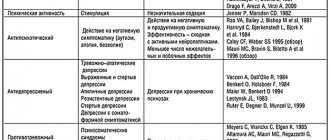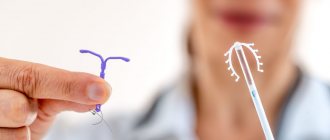Endometriosis is an immune-dependent, dyshormonal and genetically determined disease, which is characterized by benign proliferation of endometrial tissue. Endometriosis is characterized by a long and progressive course. A woman can learn about this pathology during an examination at a gynecologist or during an ultrasound diagnosis of the pelvic organs. After conducting diagnostic examinations, the doctor selects appropriate treatment with hormonal drugs or through surgery.
Endometriosis is an insidious disease, since its symptoms appear in the later stages of development of the pathology, when the lesions have reached large sizes or have degenerated into cysts. Therefore, if the menstrual cycle is disrupted, its duration is shortened, or painful sensations appear in the lower abdomen during sexual intercourse, during menstruation, or during bowel movements, you should immediately consult a doctor. It is also necessary to visit a gynecologist if you experience bleeding of unknown etiology that appears regardless of the menstrual cycle.
The reasons that can contribute to the development of endometriosis are hormonal imbalances, weakened immunity, inflammatory processes in the organs of the reproductive system and the whole body, as well as mechanical damage to the endometrium due to abortions, miscarriages, adhesions, and curettage. The condition of the genital organs is also negatively affected by poor environmental conditions, poor diet, smoking, alcohol abuse, stress and constant emotional tension.
Features of hormonal treatment of endometriosis
Since endometriosis is a hormone-dependent disease, in most cases the doctor selects hormonal medications for the patient. Even if surgery was performed, in order to avoid relapses, a course (at least 6 months) of hormonal therapy is prescribed.
Among the advantages of treating endometriosis with drugs, it is worth highlighting:
- elimination of the activity of pathological pathogenic cells;
- the ability to avoid surgery and possible complications after it;
- restoration and preservation of reproductive function;
- elimination of painful sensations that are accompanying symptoms of endometriosis.
Despite its great popularity, treating endometriosis with hormonal drugs has a number of disadvantages. Thus, long-term use of such drugs has a negative impact on the general condition of the body - the patient may develop dependence on a particular drug. Hormonal therapy is aimed at stopping the development of foci of endometriosis without eliminating the causes of this disease, so after such treatment, endometriosis may develop again over time.
With long-term use of hormonal drugs, or when a woman was prescribed inappropriate pills for the treatment of endometriosis, she may experience:
- swelling;
- nausea and vomiting;
- uterine bleeding;
- sudden weight gain;
- swelling of the mammary glands;
- headaches and dizziness;
- development of chronic diseases of the gastrointestinal tract, kidneys, cardiovascular system;
- tides;
- atrophic vaginitis.
Another disadvantage is the long duration of treatment and the high cost of some drugs.
Treatment of endometriosis with tablets is not prescribed if the patient has:
- allergic reactions to some components;
- liver diseases;
- ulcerative gastritis;
- diseases of the cardiovascular system;
- increased blood clotting;
- diabetes mellitus, pituitary insufficiency;
- increased thrombus formation;
- previous history of heart attacks or strokes.
VISANNE (tablets)
These indicate the development of some tumors.
The surgeon’s answer was categorical: “We must be patient.” And I bought a third pack (the course was prescribed for me for six months). Here it is more expensive than 3 thousand. For me, the amount is almost unaffordable, but I am very afraid of a second operation, because the people with whom I crossed paths at the clinic have already had the 2nd and 3rd rounds of surgery. One hope is menopause, but we still have to live to see it, in the literal sense. Endometriosis is not cured, but only stops for a while under the condition of restraining treatment. External endometriosis, living on other organs, is even worse, because it behaves like oncology with the only difference that it kills more slowly, affecting everything it reaches in the peritoneum. After the second pack, I did the first ultrasound after the operation, which showed that I had no fibroids, no cysts, no external endometriosis, all indicators were normal, but they discovered hydrosalpinx of the fallopian tube from the side of the incision through which the intestines were pulled out. The inflammatory process was present before I started taking Visanne, and it became the reason for the threat of a second operation looming over me, but the medicine had nothing to do with it (I read hundreds of reviews, no one complained about such a side effect). I share my “impressions”. I started taking pills from the second cycle after the operation (from the first day), although I should have immediately (I decided to check my breasts, since Visanne has contraindications for cancer alert). On the doctor's advice, I take them at night. I hesitated for a long time about how to choose the time, because I often have to work at night. I set the alarm clock every day at 11:00 p.m. so that people wouldn’t bother me in my sleep, and I regretted: I can’t change the time, I don’t have any vivid reactions that interfere with life, but now I can’t go to bed early. In fact, nothing out of the ordinary happened to me. The biggest inconvenience is that I have been spotting for almost a month on the second pack, and it is not going to stop. My body had already behaved stubbornly, refuting even post-operative forecasts, and it is fighting here too, not allowing my periods to stop, although it would be time. This is inconvenient because, although three drops are released per day, you can’t part with the pads, and in the summer the greenhouse effect gives room for the development of all sorts of inflammation, which is what I encountered. The side ones come one or two at a time, then they change. And this is good. If you don’t go into wringing of your hands and treat yourself with a bit of irony, like “Oh, how... Thank you for not yesterday,” then you can live. Now briefly about the side effects that I encountered: 1. The first period with the drug was heavy, 5 days, with a very aching back and a feeling of constantly full intestines. I felt nauseous, but only slightly. Then there was a short break and spotting, very dark discharge without pain began. 2. Insomnia due to nightly “twisting” of the muscles of the arms and legs. This is a tangible problem. Afobazole did not help. The doctor recommended Melaxen for the night. I add pain-relieving gel to this on my legs and arms when it gets tight, and everything goes away. This happened 5-6 times in two months and not every day. Not fatal. 3. From the second week, the pressure began to jump. Not for long. It settled down on its own. 4. Tides. This is not as scary as a process, although these “dunkings” cannot be called pleasant, but because of sweating, you have to wash your hair every day, even in the morning, and at work keep wet wipes and deodorant on hand at all times. If hot flashes happened at night, I woke up because I was cold and wet. I took out a blanket, but in the second month I didn’t really notice the inconvenience, I adjusted (after all, the effect of novelty puts pressure on psychology and we push ourselves with excessive attention to ourselves). 5. I don’t want to hang myself, my mood is normal, but there have been bursts of aggression towards things (I don’t rush at people, I don’t hit the cat, even when he gets me up at night), but the screen of a poorly working phone is already broken and the loop from the mosquito net, which has been in use for a long time, has been torn off. did not fit into place. I had never noticed this before. 6. In a month and a half I gained 2 kg. I got scared, returned to my favorite buckwheat and lost almost kg. It's manageable. Yes, the terrible zhor attacked several times. You can only escape from it by sleeping, otherwise, since Visanne disrupts metabolism, you can make yourself obese. More protein foods: fish, meat. peanut. 7. My hair didn’t fall out (it thinned noticeably after the anesthesia), but my teeth did fall out. I had to buy calcium.
In principle, that's all. I will do an ultrasound every two months so as not to miss if nodes or something else appears. It’s still not possible to manage without hospitals, although I had high hopes for this (before the operation, I could not be diagnosed for almost a year; it is considered rare). I’m careful not to recommend the drug to friends, because the list of side effects is too long. It is better to listen to the opinion of 2-3 good specialists in order to get involved in such adventures, but doctors will not give any guarantees. The drug is a plus for me so far, we’ll see what happens next. In my case, there is no way out. I’m very afraid of what will happen during the cancellation, but it’s 4 months away.
Good health to everyone. I will be glad if my review is useful to someone.
Treatment of endometriosis with tablets
Treatment of endometriosis with drugs is aimed at restoring hormonal balance in the body. Taking hormonal drugs “evens out” the hormonal balance, due to which the woman’s foci of endometriosis atrophy, reproductive function is restored and, if there were any, the symptoms of the pathology disappear.
The essence of hormonal treatment is as follows: the pills temporarily stop menstruation, since it is on these days that endometrioid cells begin to bleed and develop. On the remaining days of the cycle they are at relative rest.
Among the drugs for the treatment of endometriosis, depending on the active substance, the following groups are distinguished:
- Gestrions are synthetic steroids that have an increased antiprogestin effect and slow down the production of hormones by the ovaries, which leads to atrophy of endometriotic areas;
- Inhibitors of gonadotropic hormones and antigestogens that suppress the production of FSH, LH and progesterone. Among them are:
- danazol - prescribed to stop menstruation and ovulation, and also helps reduce pain and dyspareunia;
- Mifepristone - characterized by antiprogesterone activity, which prevents endometriotic lesions from bleeding.
The choice of drug and its dosage is determined by the doctor in each case individually, taking into account the patient’s age, her state of health, the form and severity of the pathology.
At the IVF Center clinic in Kaliningrad, doctors also specialize in the treatment of endometriosis using both surgery and pills, injections, and blockades. When choosing a medical institution and a doctor, you need to take into account the doctor’s experience and the clinic’s availability of modern equipment.
At the present stage, the problem of genital endometriosis has acquired particular significance due to its steady growth in the structure of gynecological morbidity (by 10% in recent years) [1].
The results of epidemiological studies show that in 90-99% of patients, endometrioid lesions are detected between the ages of 20 and 50 years, most often during reproductive age, regardless of ethnicity and socio-economic conditions [2].
A huge number of studies in domestic and foreign literature are devoted to the study of the problem of genital endometriosis. Despite this, recent scientific developments indicate ambiguity in determining both the etiology and pathogenesis of this disease [3, 7]. There are a large number of hypotheses for the origin of this “mysterious” disease. However, none of them explains the appearance of endometrioid heterotopias outside the uterine mucosa, and none of them has become definitively proven and generally accepted.
Thus, the main etiological factors for the development of endometriosis should be considered genetic predisposition, retrograde menstruation, coelomic metaplasia, activation of embryonic remains, changes in the metabolism of endometrial cells, increased proliferative activity and autonomous growth of endometrioid heterotopias, iatrogenic causes. Risk factors for the development of endometriosis include hyperestrogenism, early menarche, heavy and prolonged menstruation, obesity, smoking, stress, and unfavorable environment.
Endometriosis is a genetically determined, dishormonal, immune-dependent chronic disease with benign proliferation of tissue similar in morphological structure and function to the endometrium outside the uterine mucosa [5].
In recent years, the treatment of endometriosis has been widely discussed. Therapy for endometriosis should be comprehensive and staged. The modern and optimal approach to treating patients with endometriosis is a combination of surgery and suppressive hormonal therapy. This point of view has many supporters. We would like to focus on Visanne containing 2 mg dienogest, which was registered in Russia in 2011 [6]. Dienogest differs from other 19-nortestosterone derivatives in that it contains a 17α-cyanomethyl group instead of a 17α-ethynyl group and an additional double bond in the B ring. As a result, the size of the molecule, its hydrophobicity and polarity changed, which affected the absorption, distribution and metabolism of the compound and gave dienogest its specific properties. Dienogest is a synthetic steroid with pronounced progestogenic activity (including in relation to the endometrium), and does not have androgenic, estrogenic, antiestrogenic or corticoid-like effects. When studying dienogest in many clinical studies, it was shown that when used at 2 mg / day for 6-9 months, it has virtually no effect on lipid metabolism, and in this respect it is closer to progesterone. An important feature of dienogest, which distinguishes it from other progestogens, is its beneficial effect on the central nervous system. The results of clinical studies by T. Zimmermann [8] indicate that when using dienogest, sleep improves, concentration and memory increase, irritability and depression decrease, and this is important for patients with endometriosis. Another potential mechanism of action found for dienogest in endometriosis is related to its effect on prostaglandins E2, which are involved in the mechanisms of inflammation, proliferation, apoptosis, migration, infiltration and angiogenesis in endometriosis. According to a number of authors [2, 3], the drug is highly effective for minimal, mild, moderate stages of internal and external endometriosis, is well tolerated and causes less pronounced side effects compared to other gestagens, which expands the possibility of its use. The advantages of dienogest are the absence of “postmenopausal” disorders, symptoms of hyperandrogenism, hematological changes, and effects on bone mineral density [3]. So, the opinion [4] is correct that dienogest is a new therapeutic alternative to GnRH a after surgical treatment.
The vast majority of gynecologists recognize laparoscopy as the most accurate method for diagnosing external genital endometriosis. Laparoscopy not only makes it possible to detect foci of endometriosis and differentiate them from the tumor process with maximum accuracy (perform a biopsy of “suspicious structures”), but also in 75% of cases to establish the cause of chronic pelvic pain and/or infertility. When foci of endometriosis are localized on the surface of the peritoneum, the information content of laparoscopic diagnosis is 100%.
The purpose of this work is to evaluate the effectiveness and safety of the drug dienogest 2 mg (Visanne) in patients with diagnosed endometriosis.
Material and methods
During a 12- and 24-week observation at the gynecological department of the Moscow City Clinical Hospital No. 1 named after. N.I. Pirogov conducted a comprehensive clinical and laboratory examination and treatment of 53 patients with external endometriosis. As the main treatment, all patients underwent surgical laparoscopy, which included, depending on the type of disease, removal of endometrioid ovarian cysts - 45 (85%), foci of endometriosis on the pelvic peritoneum - 8 (15%), uterosacral ligaments - 12 (23%). ) and other localizations - 5 (9.4%).
The main group consisted of 33 patients who, after surgical treatment, were prescribed therapy with dienogest at a dose of 2 mg (Visanne). The comparison group included 20 patients who were not prescribed hormone therapy in the postoperative period, and surgical treatment was performed in 2011-2012. The average age of patients in the main group was 31±2.5 years, in the comparison group – 30±1.5 years.
A thorough analysis of the patients' medical history was carried out, including a comparison of the main factors influencing the development of endometriosis: age, heredity, the nature of menstrual and reproductive functions, the presence and nature of extragenital and gynecological pathology, etc.
The structure and frequency of gynecological morbidity in patients with endometriosis deserve special attention. The most common were: infertility - 31 (58%), chronic pelvic pain syndrome - 23 (43%), dysmenorrhea - 21 (41.5%), chronic inflammatory diseases of the genital organs - 7 (13%), to a lesser extent uterine fibroids - 4 (7%), fibrocystic mastopathy - 4 (7%) and cervical ectopia - 7 (13%).
Clinical and laboratory examination included collection of anamnestic data, general and gynecological examinations, general clinical blood test, urine test, biochemical blood test, coagulogram study, determination of the level of tumor marker CA-125, hormonal status study, chest x-ray. Ultrasound examination (US) of the pelvic organs, computed tomography (CT) of the abdominal cavity and retroperitoneal space were used as additional research methods.
The most common complaints presented by patients with external endometriosis were complaints of pain - 47 (88%), aggravated during menstruation - 17 (36.6%), sexual activity - 10 (21.2%), dysmenorrhea - 21 (41). ,5%).
In the postoperative period, 33 patients received dienogest 2 mg for 6 months. After 3 and 6 months, a control ultrasound of the pelvic organs, a biochemical blood test, a coagulogram (activated partial thromboplastin time, international normalized ratio, fibrinogen, prothrombin time, D-dimer), and determination of the tumor marker CA-125 were performed. The laboratory results obtained did not reveal significant changes.
Summarizing the results of the observation, it should be noted that in the group of patients receiving a drug based on dienogest 2 mg, in 100% of cases the disappearance of pain was noted in the 1st month of taking the drug, and the normal menstrual cycle was restored in 32 (97%) patients after 1.5-2 months after completion of hormonal treatment. Whereas in the group of patients who did not receive hormonal therapy after surgery, pain and dysmenorrhea resumed after 6 and 9 months of observation, which indicates the need to prescribe hormonal therapy.
Among the side effects in the group of patients using dienogest 2 mg (Visanne), there was only a decrease in libido - in 1 (3%) patient, in 25 - the nature of sexual life did not change, in 7 - there was no sex life.
In 1 (3%) patient with stage III endometriosis with a history of long-term infertility, a spontaneous desired pregnancy occurred in the 6th week of taking dienogest. The pregnancy proceeded without any peculiarities, ended in spontaneous labor at term, a healthy girl was born (body weight 3150 g, body length 51 cm, Apgar score 8-9 points).
As a result of the observation, it was established that Visanne (dienogest 2 mg) is highly effective in the complex treatment of patients with diagnosed endometriosis. The drug is characterized by a low level of side effects.
Thus, we cannot agree with the conclusions of a number of authors about the paramount importance of surgical intervention in the treatment of all forms of endometriosis of the pelvic peritoneum. And therefore we give preference to a combination of surgical treatment with hormonal therapy aimed at combating endometriosis.
In conclusion, it should be emphasized that, without detracting from the advantages of surgical intervention, hormonal therapy plays an important role in the complex treatment of endometriosis.








